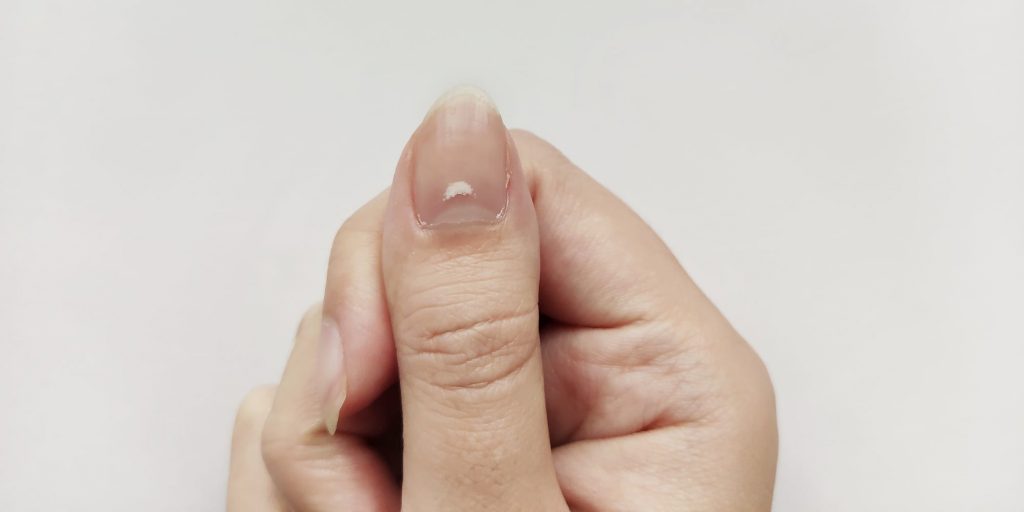You may be concerned if you see white spots appearing on your nails, but they usually aren't anything to worry about. White spots, also called leukonychia, can have a variety of causes, including damage to your nail plate, certain medications, or a fungal infection.
- You may have white spots on your nails if you have a fungal infection or a mineral deficiency.
- Getting manicures also cause white spots, since electric files can damage the surface of your nail.
- White spots can also be a symptom of retinoids, antibiotics, or blood pressure medications.
- Visit Insider's Health Reference library for more advice.
Here are five reasons why white spots might appear on your nails and how you can treat them.
1. Damage from manicures
Getting your nails done can damage the skin underneath your nail, called the nailbed.
"This type of damage can occur during a manicure if your manicurist isn't gentle enough when grooming the nail with sharp tools," says Dendy Engelman, MD, a board certified cosmetic dermatologist at the Shafer Clinic, NYC.
For example, "overuse of an electric file or aggressively pushing back the cuticles using a metal tool can damage the nail," says Michele Green, MD, a board certified cosmetic dermatologist with a private practice in NYC.
White spots can also be the result of repeated trauma to the nail bed — this means that getting manicures too often can cause spots, even if there isn't a significant injury, says Engelman.
Manicure damage can also make your nails crack, peel, or become brittle.
How to treat it: The best way to treat nail damage is just letting the nail grow out, Green says. It's also best to seek out nail technicians that are trained in applying and removing nail enhancements without damaging the nail bed.
2. Fungal infection
Another common cause of white spots on your nails is fungal infections. These happen when microbes from the environment get in through small cracks in your nails or the surrounding skin.
According to Green, you should take these steps to prevent nail fungus:
- Wash your feet and hands thoroughly and dry completely.
- Change your socks daily.
- Be sure to wear shoes that are well fitted, ventilated, and not too tight.
- Seek out nail salons that are clean and that sterilize or discard their instruments after each client.
- Avoid walking barefoot in public spaces like the gym locker room.
Other signs that you have a fungal infection include your nail cracking, growing thicker, or turning yellow or brown.
How to treat it: To treat a fungal infection, your doctor will likely prescribe oral antifungal medication. Fungal infections clear up slowly, so it can take several months for your nail to heal completely. In more severe cases, your doctor may have to completely remove the nail.
3. Mineral deficiency
Some experts say that white spots on your nails may be a sign that you're deficient in minerals like calcium or zinc.
"Because the nail plate is made of a variety of nutrients in certain proportions, a deficiency in nutrients can show on the nails," Green says.
But other experts dispute this idea and say that the spots are more likely to be from a minor injury. More research is needed to determine what the truth is.
There are several more reliable signs that you have a mineral deficiency, including:
- Low calcium levels can cause:
- Dry skin
- Brittle nails
- Muscle cramps
- Coarse hair
- Memory loss
- Low zinc levels can cause:
- Hair loss
- More frequent infections like the common cold
- Decreased appetite
- Slower wound healing
- Diarrhea
- Irritability
4. Certain medications
Some medications can interrupt your nail growth or damage your nail beds, causing white lines to appear across the nail.
Many different drugs can interrupt your nail growth including:
- Chemotherapy drugs for cancer
- Retinoids, which are used to treat acne
- Some antibiotics, including sulfonamides and cloxacillin
- Lithium
- Anticonvulsant drugs like carbamazepine
- Antifungals like itraconazole
- Some blood pressure medications like metoprolol
These medications can also cause symptoms like slow nail growth, nail thinning, and brittleness.
How to treat it: There is no treatment for drug-induced nail spots, but you can talk to your doctor about switching to another medication.
5. Heavy metal poisoning
In rare cases, white spots can be a sign that you've come into contact with toxic heavy metals like thallium and arsenic. This can happen if you eat contaminated foods or breathe in industrial fumes.
- Arsenic poisoning can cause white bands called Mees' lines to develop across your nails, along with:
- Headaches
- Drowsiness
- Confusion
- Diarrhea and vomiting
- Fever
- Low blood pressure
- Thallium poisoning can also cause Mees' lines, along with symptoms like:
- Nausea or vomiting
- Abdominal pain
- Extreme drowsiness
- Hair loss
- Nerve pain
- Seizures
If you have any of these symptoms, see your doctor as soon as possible.
Insider's takeaway
There are many different reasons why white spots might appear on your nails, including injuries, heavy metal poisoning, or fungal infection.
But in most cases, there's no need to be alarmed —"it is very common, and the cause is most likely easily treatable, or will go away on its own," Engelman says.
"See your doctor and/or dermatologist to learn what might be causing the white spots, and how to get rid of them," says Engelman.
